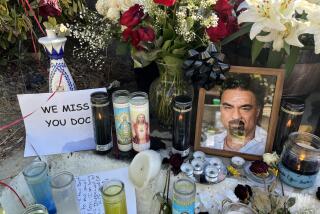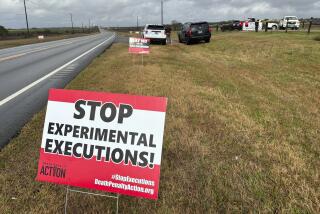Attack May Be Tied to Autopsy, Police Say
O.C. Smith, the medical examiner in Memphis, Tenn., is known for his contentious findings. Some of his colleagues in the no-nonsense world of forensic pathology have even said that “he reaches.”
On Tuesday, investigators said that one of Smith’s autopsies likely was behind an attack that left the 49-year-old pathologist hogtied outside his office last weekend with a bomb ticking on his chest.
“He’s worked some pretty controversial cases that made people upset,” Memphis police inspector Matt McCann said. “That’s who probably did this.”
Police rescued Smith before the bomb went off, and the wiry doctor was back at work the next day. He’s declined interviews, saying he is concerned about his safety.
To fellow medical examiners, the circumstances of the attack are weird--but the fact that a forensic pathologist was targeted is not.
“I’ve gotten stalked and threatened countless times,” said Stanton Kessler, formerly Boston’s chief medical examiner. “That’s what you get in this job. You deal with nuts.”
Often, a medical examiner’s analysis of a mysterious death or grisly crime scene can spell the difference between guilt and innocence in a murder trial.
Memphis investigators believe that a man enraged about Smith’s role in a cop-killer case ambushed him around 10 p.m. Saturday as he was leaving his office, the Shelby County Regional Forensic Center.
He told police that the attacker splashed fluid in his face, slugged him to the ground, tied him up with barbed wire and attached a small explosive device to his chest. Police wouldn’t say what kind of bomb it was.
“But it was live,” McCann said. “It could have killed him.”
Smith could not identify the attacker. But police think it was the same person who wrote a threatening letter last year calling Smith a “killer” and a “soulless demon.” The author accused Smith of lying in his testimony regarding Philip Workman, who now is on death row.
Workman was convicted of killing a police officer and wounding another during an armed robbery at a Wendy’s restaurant in 1981. The bullet that killed Lt. Ronald Oliver was never found, and Workman always has insisted that it was another cop who shot Oliver in a friendly-fire exchange.
His case has become a cause celebre among death penalty critics.
Last year, when Workman came up for a clemency hearing, Smith used electron microscopy--which can magnify an object up to 10 million times--to determine that there were flecks of aluminum in the officer’s tissue samples, implicating Workman as the gunman.
The gun Workman had on the night of the robbery was loaded with aluminum-jacketed bullets.
But two pathologists have cast doubt on Smith’s findings.
Cyril Wecht, Pittsburgh’s chief medical examiner and president of the American Board of Legal Medicine, said: “Nobody in forensics has used electron microscopy before. It wouldn’t meet peer review standards and shouldn’t have been accepted.”
Werner U. Spitz, author of “Medicolegal Investigation of Death”--which is considered to be the bible of forensic pathology--also said there was no scientific basis for Smith’s conclusion.
“In this case, he reaches,” Werner said. “And that’s wrong. You can’t be an advocate for anyone in this business.
“Your job is to go in there and tell the truth,” Werner added.
Both have said they would testify on behalf of Workman, whose case is under appeal.
In response to questions, a spokeswoman for Smith issued a statement Tuesday saying: “We feel that it is important that we not engage in starting a debate of any kind that may inflame the attacker and have the potential to create an increased safety issue for Dr. Smith.”
Kessler, the former Boston medical examiner, said Smith is very careful and meticulous.
“It’s true that he’s aggressive and he’s a bulldog,” Kessler said. “But I know he really believes in what he does.”
More to Read
Sign up for Essential California
The most important California stories and recommendations in your inbox every morning.
You may occasionally receive promotional content from the Los Angeles Times.










